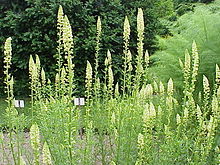- Reseda (plant)
-
Reseda 
Reseda lutea (Wild Mignonette) Scientific classification Kingdom: Plantae (unranked): Angiosperms (unranked): Eudicots (unranked): Rosids Order: Brassicales Family: Resedaceae Genus: Reseda
L.Species About 50-70 species, including:
Reseda alba - White Mignonette
Reseda complicata Glaucous Mignonette
Reseda lutea - Wild Mignonette
Reseda luteola - Weld
Reseda odorata - Common Mignonette
Reseda phyteuma - Corn Mignonette
Reseda scoparia - Canaries MignonetteMignonette (Reseda) is a genus of fragrant herbaceous plants native to the Mediterranean region and southwest Asia, from the Canary Islands and Iberia east to northwest India. The species include annuals, biennials and perennials, and grow to 40-130 cm tall. The leaves form a basal rosette at ground level, and then spirally arranged up the stem; they can be entire, toothed or pinnate, and range from 1-15 cm long. The flowers are produced in a slender spike, each flower small (4-6 mm diameter), white, yellow, orange, or green, with four to six petals. The fruit is a small dry capsule containing several seeds.
Other common names include Weld (R. luteola), Dyer's Rocket, Bastard Rocket and Sweet Reseda.
Cultivation and uses
Propagation is by seed, which is surface-sown directly into the garden or grass verge. The plant does not take well to transplanting and should not be moved after sowing.
Mignonette flowers are extremely fragrant. It is grown for the sweet ambrosial scent of its flowers. It is used in flower arrangements, perfumes and potpourri. A Victorian favourite, it was commonly grown in pots and in window-boxes to scent the city air. It was used as a sedative and a treatment for bruises in Roman times. The volatile oil is used in perfumery. The yellow dye was obtained from the roots of R. luteola by the first millennium BC, and perhaps earlier than either woad or madder. Use of this dye came to an end at the beginning of the twentieth century, when cheaper synthetic yellow dyes came into use.[1]
Charles Darwin used R. odorata in his studies of self-fertilised plants, which he documented in The Effects of Cross and Self-Fertilisation in the Vegetable Kingdom.
Notes
- ^ Daniel Zohary and Maria Hopf, Domestication of plants in the Old World, third edition (Oxford: University Press, 2000), p. 209
External links
- Mignonette - Offers more information about mignonette.
- Data sheet with pictures of weld (Reseda luteola L.) (in German)
Dyeing Techniques Batik · Dyeing · Kalamkari · Katazome · Leheria · Mordant · Reactive dye printing · Resist · Ring dyeing · Rōketsuzome · Shibori · Tie-dye · TsutsugakiTypes of dyes Traditional textile dyes History Craft dyes Reference Glossary of dyeing terms · List of dyesCategories:- Resedaceae
- Plant dyes
Wikimedia Foundation. 2010.

